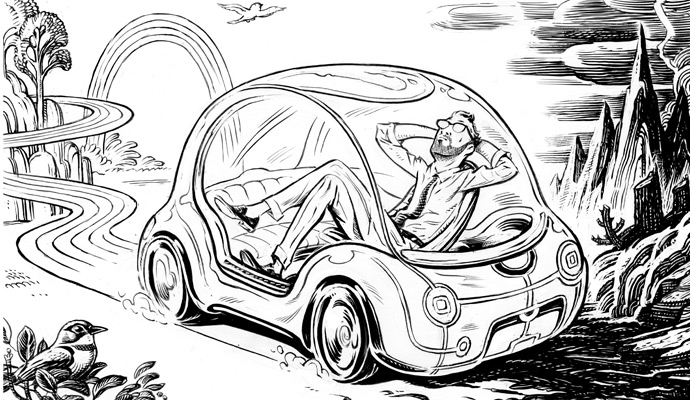The Coming Boom in Hybrid Cars
Evidence from innovation theory and auto-industry history suggests that the market share for hybrids is about to accelerate sharply.
(originally published by Booz & Company)Hybrids — the fuel-efficient autos that combine electric motors with internal combustion engines — have been getting a lot of buzz in the U.S. lately, especially with gasoline prices of US$4.00 to $5.00 per gallon. There are waiting lists for the most popular hybrids, such as the Toyota Prius, and automakers are scrambling to introduce dozens of new models. But hybrids' share of the new-car market is still in low single digits, and skeptics question whether they will really break into the automotive mainstream or whether sales will dwindle if gasoline prices fall back from their recent record highs. An analysis of the theory of innovation and the history of the auto market suggests that the hype about hybrids is justified and indicates that hybrids should account for a robust 17 percent share of total vehicle sales as early as 2010. Moreover, history suggests that these market-share gains are not dependent on high gasoline prices and that the market share of the next generation of hybrids — the plug-in hybrid — should grow even more quickly.
One tested method of estimating the growth of market share for an innovation in an existing market is the S-curve, a mathematical model that was first used in biology to predict the growth rates of living things and has since been adapted by economists and management theorists to describe the growth paths of innovations. The S-curve has predicted accurately the exponential, cumulative rate of adoption for innovations as varied as the automobile in a market for horses, fuel oil in a market for coal, and TV films in a market for full-length features. The three stages of growth for an S-curve innovation are commercialization, adoption, and maturation.
My research shows that the market penetration of the hybrid car, since its launch seven years ago, forms a nearly perfect S-curve when graphed. Furthermore, the circumstances surrounding the proliferation of hybrids conform perfectly to the stages that S-curve theory dictates they should. For instance, in the commercialization stage, market share rises slowly from 0.1 percent to 1 percent as sales are driven by early adopters and enthusiasts — those adventurous consumers who are willing to pay a premium and accept the risks of investing in a cutting-edge technology. In the adoption stage, an S-curve innovation should be in a period of rapid public acceptance as the product gains greater visibility and consumer trust, and as scaled production drives down manufacturing costs. In this stage, market share should rise from 1 percent to 10 percent in the same amount of time that the market share in the commercialization stage went from 0.1 percent to 1 percent.
For hybrids, the commercialization stage lasted from 2001, when the first hybrids became widely available, to 2005, when market share surpassed 1 percent. Within this stage, the fastest increase in the rate of market penetration came in 2004, when Ford released its Escape hybrid SUV, the first model outside the subcompact and compact categories, putting the new technology firmly into the automotive mainstream.
Because hybrids accomplished the commercialization stage in approximately four years (between 2001 and 2005), the S-curve predicts that hybrids, now in their adoption stage, will achieve a 4 percent market share in 2008, which seems likely. Hybrid market share broke 3 percent for the first time in April 2008, and record gas prices sent summer sales through the roof. As the adoption stage continues, the S-curve suggests a hybrid market share of around 10 percent by the end of 2009. Well in line with this rule of thumb, my data, based on recorded growth rates and market-share figures from the past seven years, predicts a 9 percent market share for hybrids in 2009 and a ripe 17 percent share by the end of 2010. Should sales fall slightly short of the S-curve’s predictions, it may owe less to consumers’ purchasing preferences than to supply issues, as manufacturers are struggling to keep up with demand. There are six-month waiting lists in parts of the country for the Toyota Prius, the best-selling hybrid model.
Some commentators have questioned whether hybrid sales will fall if gasoline prices decline from their recent record highs. They draw an analogy to the fate of small, fuel-efficient cars in the late 1970s and early 1980s — the last time there was a major rise and fall in fuel prices. I believe that this will not be the case for two reasons. First, although record gas prices certainly enhanced the hybrid’s appeal, allowing the benefits of scale and visibility to root faster in the adoption stage, the market-share increases of hybrids were closely following the S-curve path even before the recent spike in gasoline prices, suggesting that adoption of the new technology is not closely tied to fuel prices.
The second reason is that the analogy with the experience of small cars during the last fuel crisis is flawed. A closer look at the buying trends that were in place then provides further evidence that the fate of hybrids may not be closely correlated with future gasoline prices. During the oil crisis of the 1970s, mini-compacts, such as the Mini Cooper — then the smallest auto available in the U.S. — achieved their highest market share in 1978, when gasoline prices were high. But mini-compacts never really caught on, and their market share declined even as gas prices rose further. The slightly larger subcompacts, such as the Volkswagen Beetle, grew market share only when prices were rising, and lost share from 1982 onward. Compact cars, however, like the Ford Escort and Honda Civic, became widely popular, and the compact class has held the single greatest market share of any segment for nearly every year since 1980. The conclusion we draw from this episode is that the mini-compact was too small to gain wide acceptance among U.S. buyers; the subcompact was still small enough that its market share held up only when fuel prices were high; and the compact has proven to be the most popular compromise between size and efficiency.
Today, the most popular hybrids fall into the compact category, providing the spaciousness that consumers have demanded but offering fuel efficiency as good as or better than the mini-compact and subcompact models of the late 1970s. Moreover, hybrid power trains are being successfully adapted to most vehicle classes, allowing them to appeal across all market segments. All that presently stands to dissuade car buyers from choosing hybrids is a lack of variety and, in times of low gas prices, a slight price premium compared with otherwise similar models. And as production prices fall during the adoption stage of the S-curve, the price premium should disappear.
Automotive history also suggests that the next iteration of hybrid technology — the plug-in hybrid — may be poised to make even larger market-share inroads. Although plug-ins are not yet commercially available, prototypes have been tested extensively. Automakers, including GM and Toyota, are pouring billions into their development, and some models, such as the Chevrolet Volt, are set to debut in 2010. These vehicles feature rechargeable lithium-ion batteries that can be recharged from a conventional electric outlet and can store more energy than the nickel-hydride variety used in the current generation of hybrids. In plug-in hybrids, the electric motor is the primary source of power, and a small internal combustion engine serves as an auxiliary power source. The biggest limitation on plug-in technology currently is the cost of the lithium-ion batteries.
But as battery prices come down, plug-ins could capitalize on the trail blazed by the current generation of hybrids, which has helped consumers grow more comfortable with nontraditional engine types. Across industries and product lines, consumers characteristically respond more aggressively to improvements made to a successful innovation than to the initial innovation. For instance, when the minivan hit the market in 1984, it enjoyed unrivaled success, as there was no other vehicle available that offered a similar combination of form and function. But the minivan’s success was surpassed by the midsized SUV, introduced in 1988. It captured the positive attributes of the minivan (space, size, family friendliness) and expanded on them, offering better styling and driving performance. Today the midsized SUV’s market share is 13.6 percent, compared with 5.1 percent for the minivan.
It is not difficult to imagine a similar interaction between the hybrid and the plug-in hybrid. With all the positive attributes of the conventional hybrid, as well as significantly better fuel economy, the plug-in could very well be the midsized SUV of the next decade. If that happens, the plug-in will certainly need a new S-curve of its own, and both auto manufacturers and dealers should be prepared for a faster-than-expected increase in demand. In the meantime, however, we can place confidence in the S-curve’s prediction that the conventional hybrid, regardless of the future path of gas prices, is here to stay.![]()
Christopher Giliberti is an undergraduate at Tufts University. He is the editor-in-chief of Hemispheres, Tufts’s undergraduate journal of international affairs, and a business associate at the graduate-school publication the Fletcher Forum of World Affairs. He completed this study with guidance and support from his father, Louis Giliberti, a former Booz Allen Hamilton vice president.




